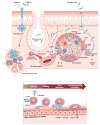B-lymphocyte lineage cells and the respiratory system
- PMID: 23540615
- PMCID: PMC3628816
- DOI: 10.1016/j.jaci.2013.02.023
B-lymphocyte lineage cells and the respiratory system
Abstract
Adaptive humoral immune responses in the airways are mediated by B cells and plasma cells that express highly evolved and specific receptors and produce immunoglobulins of most isotypes. In some cases, such as autoimmune diseases or inflammatory diseases caused by excessive exposure to foreign antigens, these same immune cells can cause disease by virtue of overly vigorous responses. This review discusses the generation, differentiation, signaling, activation, and recruitment pathways of B cells and plasma cells, with special emphasis on unique characteristics of subsets of these cells functioning within the respiratory system. The primary sensitization events that generate B cells responsible for effector responses throughout the airways usually occur in the upper airways, tonsils, and adenoid structures that make up the Waldeyer ring. On secondary exposure to antigen in the airways, antigen-processing dendritic cells migrate into secondary lymphoid organs, such as lymph nodes, that drain the upper and lower airways, and further B-cell expansion takes place at those sites. Antigen exposure in the upper or lower airways can also drive expansion of B-lineage cells in the airway mucosal tissue and lead to the formation of inducible lymphoid follicles or aggregates that can mediate local immunity or disease.
Copyright © 2013 American Academy of Allergy, Asthma & Immunology. Published by Mosby, Inc. All rights reserved.
Figures





References
-
- Salvi S, Holgate ST. Could the airway epithelium play an important role in mucosal immunoglobulin A production? Clin Exp Allergy. 1999;29:1597–605. - PubMed
-
- Drolet JP, Frangie H, Guay J, Hajoui O, Hamid Q, Mazer BD. B lymphocytes in inflammatory airway diseases. Clin Exp Allergy. 2010;40:841–9. - PubMed
-
- Wilkes DS, Twigg HL., 3rd B-lymphocytes in the lung: a topic to be revisited. Sarcoidosis Vasc Diffuse Lung Dis. 2001;18:34–49. - PubMed
-
- Brandtzaeg P. Potential of nasopharynx-associated lymphoid tissue for vaccine responses in the airways. Am J Respir Crit Care Med. 2011;183:1595–604. - PubMed
-
- Kurosaki T, Shinohara H, Baba Y. B cell signaling and fate decision. Annu Rev Immunol. 2010;28:21–55. - PubMed
Publication types
MeSH terms
Substances
Grants and funding
LinkOut - more resources
Full Text Sources
Other Literature Sources

